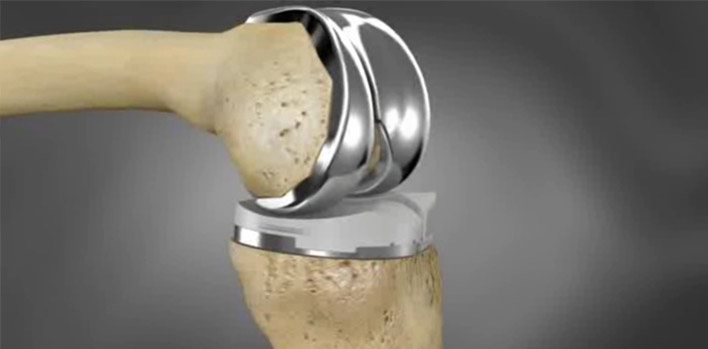What is Knee Prosthesis?
Friday, July 28, 2017 | Healthy lifestyle
Our joints are hip, knee and ankle joints that provide our work, shoulder joints that enable us to do our job and use our arm, and often joints that perform prosthetic surgery (arthroplasty).
Of them; Hip and knee joints are the most common prosthetic surgery. Our leg joints, which enable us to carry out the movements we have made in our daily life, such as carrying our body weight for years, doing sports, sitting, getting up, start to deteriorate and create problems over time.
The knee joint is used with an average adult maneuvering rate of 10-15% per day, with an average of 4000-10,000 rpm. 15-20% of the time a person doing a sports day is 14-20 thousand revolutions in a period. With age, weight, daily use, and genetic factors, joint cartilage deteriorates over time.
This deterioration limits the movement of the joint over time. It causes pain. It prevents us from doing our daily life movements.
Knee joint is most common;
Osteoarthritis (a disease known as arthritis)
Rheumatoid arthritis (known as inflammatory rheumatism)
Trauma (fractures and joint injuries) results in disruption.
Drug treatments, exercises are applied according to the degree of disability and age. Physical therapy and intra-articular injection treatments are then applied. If the deterioration does not improve with medical treatment; Meniscus operations, cartilage repairs, medical - biological solutions are applied.
As the deterioration increases, the joint is forced to perform its normal daily activities. They can not walk because of the pain, they start to struggle when they go up and down the stairs.
The biological solution that will protect the joint after this step; Not present day conditions.
The job to do is to decide the lifestyle. Either to take medicines continuously, to accept the decline in daily activities, or to accept knee replacement with artificial materials (knee prosthesis) if the health condition allows.
In what conditions will the knee prosthesis be applied?
Knee prosthesis is applied for two reasons. Pain and limitation in daily life. Although pain is an important factor; It is necessary to determine the extent to which the joint has deteriorated and whether solutions to protect the joint are possible. If treatments to protect the joint are possible, it is necessary to apply these treatments first. The joint becomes deformed over time and loses its movement, making it difficult for the patient to realize his daily life. They begin to have difficulty walking, stairs going up and down, and difficulty sitting up. Prosthetic surgery is recommended if the joint is irreversibly damaged, age and health conditions are favorable. The average life expectancy of the knee prosthesis in the human body is 15-20 years. For this reason, knee prosthesis application is recommended between the ages of 50-80. Under 50 years old; We are not trying to apply knee prosthesis as much as possible. However, in inflammatory rheumatic disease or severe intra-articular fractures, we sometimes apply knee prosthesis at an early age. We do not usually recommend knee prosthesis for ages 80 and older. The patient's general health condition, existing illnesses, and bone eradication and post-operative healing time extend, complication rate increases. For these reasons; After this age, knee prosthesis operation is decided by evaluating general condition and activity level.
Do knee prosthesis have complications?
After the operation of the knee prosthesis, four main problems are encountered. These;
Infection,
Intravenous blood clotting in the leg veins and the resulting embolism
Pain
Technical problems related to prosthesis application
In order not to encounter these complications, we take various measures. The planned operation of the patient; Dental infection, urinary tract infections, or any previous infectious disease, they will not be operated until their treatment is complete. The necessary precautions are applied meticulously during the post-operative care period. In addition to these; Antibiotic treatment for infection prevention is applied to the patient who will have prosthetic surgery. Blood-thinning drugs are used to avoid intra-arterial blood clotting in the thromboemboli and leg veins and consequent embolic problems that can occur as a result. Mechanical measures are also taken until the patient is lifted. The varicose veins and leg-muscle exercises begin early.
Technical problems of pain and prosthesis application and other problems that can be seen.
The incidence of all these complications does not exceed 10%.
Any kind of knee prosthesis?
Knee prosthesis; Is the process of replacing bone surfaces forming the joint with metal surfaces. According to the number of changed surfaces; Generally; Total knee prosthesis and unicompartmental knee prosthesis are applied. Cemented, cementless; There are alternatives such as protecting the bond, cutting the bond.
How much pain do I get after knee prosthesis, when do I walk, when will I return to normal?
The first day after surgery is pain due to surgery. In order to reduce this pain, patient controlled pain pumps, various painkiller applications and intraoperative intraoperative analgesic combinations are applied. The first day is a bit painful, and from the second day is usually acceptable pain.
Post-prosthesis rehabilitation
Cold application is performed to relieve the problem of posterior heat increase after surgery. On the day of surgery, foot - leg pump exercises begin with in - bed exercises. Starting from the first day, physiotherapist accompanied by exercises to reinforce muscles and to recover joint range of motion. With the help of a walker it takes 24-48 hours to get up and run. It is trained on how to do everyday activities such as standing, sitting, sitting on a toilet, climbing stairs. As soon as enough knee joint movement is achieved, the patient is discharged after the walking and daily activities have become partially or wholly attainable.
Information is given about exercises and practices at home.
It usually becomes unbuttoned in 2-4 weeks, depending on the age and general condition of the patient. If sufficient joint movement can not be achieved 2-3. Week physical therapy program is recommended. After the operation, knee flexion (flexion) becomes somewhat less than normal individuals. Better than the amount of bending before surgery, prayer must be done in the seat, at the table, in the toilet, and in the alafranga toilet. They can not do sit-ups at the same time they can not do before surgery, nor after surgery.
Is knee prosthesis a safe practice?
Work done, and our implementation results; 90% of the knee prosthesis is a successful and reliable method. Proper patient selection, successful surgical technique, and postoperative rehabilitation make the patient's life more comfortable.
They do daily walks, they do not have problems going up and down stairs.
Patients usually after surgery; I express these thanks to the feelings that I have suffered from these sores, I have had good surgery, and I have recovered from using drugs every day.
Dr. Cuma Kılıçkap












